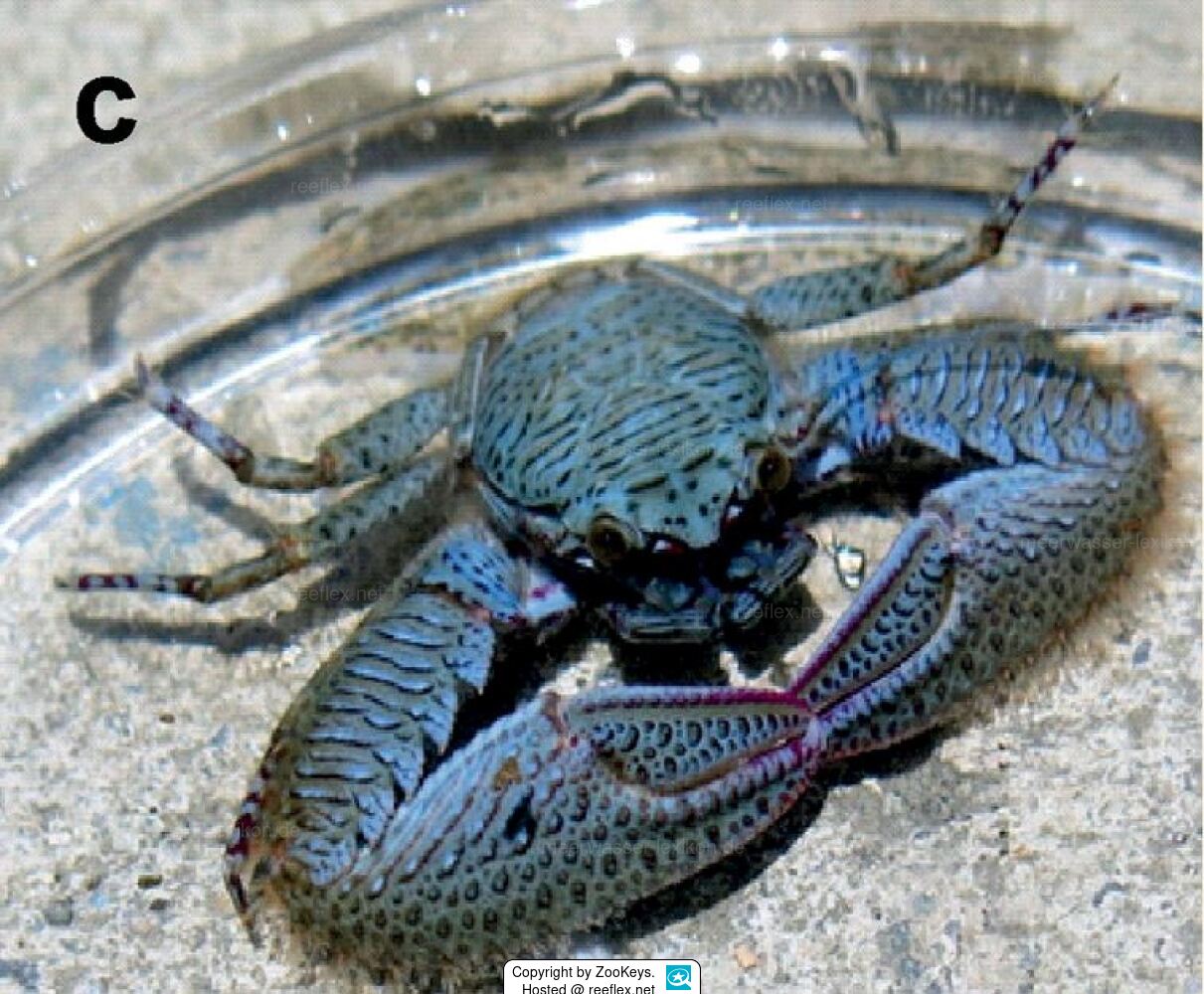Info
Petrolisthes coeruleus sp. nov.
Petrolisthes are porcelain crabs that are native to Caribbean waters, where they can be found on hard bottoms and coral rubble down to depths of 100 metres. In contrast to the porcelain crabs of the genus Neopetrolisthes, Petrolisthes does not require sea anemones or other hosts.
Petrolisthes species are absolutely reef-safe and peaceful.
The name coeruleus refers to the bluish colouration of the carapace and extremities, which is a reliable diagnostic feature for distinguishing this species from P. caribensis. Petrolisthes bolivarensis, for example, was at times thought to be a variation of Petrolisthes galathinus, but was then described as a separate species in 2003.
While Petrolisthes caribensis is a typical inhabitant of shallow-water coralline environments, mostly in the dead bases of the finger coral Porites porites (Pallas), Petrolisthes coeruleus sp. nov. has a wider habitat spectrum and depth range, as it occurs under boulders in protected sites of the surf zone. The authors found the species on roots of the red mangrove Rhizophora mangle L. in a coastal lagoon in the Colombian Gulf of Morrosquillo (9°41.684'N, 75°41.135'W), and also in the furrows of the giant barrel sponge Xestospongia muta (Schmidt, 1870) at 8 m depth in the same locality (Table 2). Sequences of the 16S DNA gene previously published by the authors and deposited in the GenBank database (www.ncbi.nlm.nih.gov/Genbank: sequences published as P. galathinus “Blue”, Accession No. DQ444890–DQ444898) match a sequence from the Yucatán Peninsula collected at 20–29m, published as P. galathinus by Bracken-Grissom et al. (2013; accession no. KF182548). This record increases the depth range of the new species, which extends from the upper subtidal at 0.5 m to 29 m depth.
Hiller A, Werding B (2024) Description of a new species of the Petrolisthes galathinus complex from the Caribbean Sea, and resurrection of Petrolisthes occidentalis from the East Pacific (Crustacea, Anomura, Porcellanidae). ZooKeys 1191: 391-407
Petrolisthes are porcelain crabs that are native to Caribbean waters, where they can be found on hard bottoms and coral rubble down to depths of 100 metres. In contrast to the porcelain crabs of the genus Neopetrolisthes, Petrolisthes does not require sea anemones or other hosts.
Petrolisthes species are absolutely reef-safe and peaceful.
The name coeruleus refers to the bluish colouration of the carapace and extremities, which is a reliable diagnostic feature for distinguishing this species from P. caribensis. Petrolisthes bolivarensis, for example, was at times thought to be a variation of Petrolisthes galathinus, but was then described as a separate species in 2003.
While Petrolisthes caribensis is a typical inhabitant of shallow-water coralline environments, mostly in the dead bases of the finger coral Porites porites (Pallas), Petrolisthes coeruleus sp. nov. has a wider habitat spectrum and depth range, as it occurs under boulders in protected sites of the surf zone. The authors found the species on roots of the red mangrove Rhizophora mangle L. in a coastal lagoon in the Colombian Gulf of Morrosquillo (9°41.684'N, 75°41.135'W), and also in the furrows of the giant barrel sponge Xestospongia muta (Schmidt, 1870) at 8 m depth in the same locality (Table 2). Sequences of the 16S DNA gene previously published by the authors and deposited in the GenBank database (www.ncbi.nlm.nih.gov/Genbank: sequences published as P. galathinus “Blue”, Accession No. DQ444890–DQ444898) match a sequence from the Yucatán Peninsula collected at 20–29m, published as P. galathinus by Bracken-Grissom et al. (2013; accession no. KF182548). This record increases the depth range of the new species, which extends from the upper subtidal at 0.5 m to 29 m depth.
Hiller A, Werding B (2024) Description of a new species of the Petrolisthes galathinus complex from the Caribbean Sea, and resurrection of Petrolisthes occidentalis from the East Pacific (Crustacea, Anomura, Porcellanidae). ZooKeys 1191: 391-407







 ZooKeys
ZooKeys




























